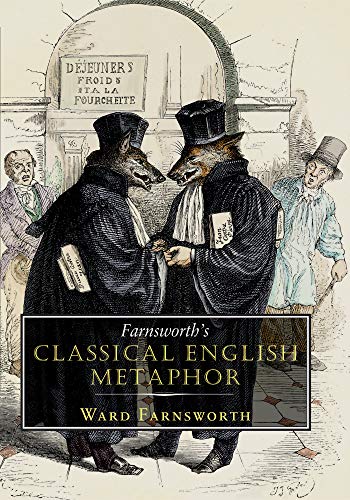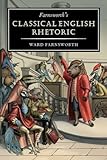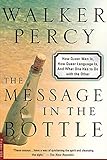
In 2010, Farnsworth’s Classical English Rhetoric became an unlikely bestseller and was immortalized here at The Millions by Steven Dodson. Rhetoric functions on a micro scale, and some of its instructive value may even come across as perfunctory because, like linguistics and grammar, we all regularly employ rhetorical techniques without knowing their names.
 But even for those familiar elements, there is still use in learning its definition and seeing some effective examples. For instance, here is Ward Farnsworth on asyndeton, which is when a writer omits a conjunction that would ordinarily be there:
But even for those familiar elements, there is still use in learning its definition and seeing some effective examples. For instance, here is Ward Farnsworth on asyndeton, which is when a writer omits a conjunction that would ordinarily be there:
a. The omission of the conjunction is irregular and unexpected, and thus can create a moment of emphasis.
b.The omission suggests that each of the items has independent force…
c. Omitting conjunctions may suggest that the items mentioned are restatements of one another, or that each is a substitute for the last, rather than a list of independent entries.
And so on through the letter g. Though we all undoubtedly have read and used asyndeton, it is unlikely that many were aware of the term or had heard it defined so eloquently. People rarely realize the linguistic tools in their arsenal but still use them to their full effect; English speakers can conjugate a verb into the pluperfect verb tense, successfully and comprehensively, without ever having heard of it by name.

 Besides helping common readers understand the things they’re already saying and making them very easy to understand, Farnsworth also takes you on a tour of literary efficacy. Rhetoric as a subject, and Farnsworth as a writer, are not interested in the larger and more ineffable artfulness of literature — structure, setting, character, dialogue, et al (and good thing, too, because those components are not teachable the way rhetoric is, and often those how-to-write-better volumes end up discouraging and daunting, as if one’s inability to learn from The Great Gatsby or In Cold Blood pointed to an overall failing. I’ve read over a dozen such books, and mostly they succeed only at showing just how great the great writers are, and just how large the gap between you and them really is).
Besides helping common readers understand the things they’re already saying and making them very easy to understand, Farnsworth also takes you on a tour of literary efficacy. Rhetoric as a subject, and Farnsworth as a writer, are not interested in the larger and more ineffable artfulness of literature — structure, setting, character, dialogue, et al (and good thing, too, because those components are not teachable the way rhetoric is, and often those how-to-write-better volumes end up discouraging and daunting, as if one’s inability to learn from The Great Gatsby or In Cold Blood pointed to an overall failing. I’ve read over a dozen such books, and mostly they succeed only at showing just how great the great writers are, and just how large the gap between you and them really is).
Farnsworth focuses on subtler and more achievable examples, like this one for asyndeton, which comes from former MP Neil Kinnock: “The House of Lords must go — not be reformed, not be replaced, not be reborn in some nominated life-after-death patronage paradise, just closed down, abolished, finished.” This is an extremely effective use of asyndeton but it’s also clear and practically instructive example. You can see how you might use it.
Farnsworth’s Rhetoric succeeded despite the many barriers to success in the marketplace for a book on classical writing because it repeatedly and implicitly reiterates the reasons these rhetoricians and writers were so successfully and memorably communicative. But instead of merely extolling their virtues and leaving the aspiring writer in the literary dust, Farnsworth, by getting down to the nitty-gritty of sentences, actually winds up doing something much more worthwhile — that is, he uses iconic figures as representative examples without making the reader feeling hopelessly inadequate. When Charles Dickens or Herman Melville, et al, put all their sentences together, something enigmatic and more profoundly artful emerges — but that doesn’t mean we can’t learn from the sentences without even stepping into the paragraphs or the chapters in which they appear.
With his last book, Farnsworth was able to make ancient methodologies relevant, the craftsmanship of major authors explicable, and the fine and minute mechanisms teachable. And all of it done with typical British primness — i.e., with unceremonious eloquence, zero contemporaneous sources, and little humor — which actually aids in Farnsworth’s project, because it means he doesn’t fuck around. With each chapter set up like an entry in a dictionary, his Rhetoric is like an encyclopedia of selected terms, less essayistic than it is economical, which ought to make it dry and dull. There is no fat in Farnsworth’s work, but it’s nonetheless a nourishing meal.
 Now, six years on, Farnsworth has produced a sequel (a term associated more with Hollywood franchises than with manuals on literary technique). Farnsworth’s Classical English Metaphor duplicates its predecessor in approach and structure and voice and directness, and for all intents and purposes is just as fun and accessible, too. But Farnsworth’s latest subject, the metaphor, makes his follow-up better and more insightful than the first one, but also, in some ways, less useful, a fact that has less to do with Farnsworth’s skill and more to do with the metaphor’s nuanced utility. It is not that Farnsworth doesn’t do an excellent job illuminating the various ways we use language to compare things — sometimes the only means of apt description — or that his examples are less instructive or applicable. Rather, it is that the metaphor is simply employed far less often than the enormous toolbox of rhetoric, and, when it is used, its power stems less from its structure and more from the lucidity and the inventiveness and the clarity of the comparison. Metaphors have a quality of “wrongness,” as Walker Percy put it in 1975’s The Message in the Bottle (a book way too recent to have assumed Farnsworth has read it), and “that its beauty often seems proportionate to its wrongness or outlandishness.”
Now, six years on, Farnsworth has produced a sequel (a term associated more with Hollywood franchises than with manuals on literary technique). Farnsworth’s Classical English Metaphor duplicates its predecessor in approach and structure and voice and directness, and for all intents and purposes is just as fun and accessible, too. But Farnsworth’s latest subject, the metaphor, makes his follow-up better and more insightful than the first one, but also, in some ways, less useful, a fact that has less to do with Farnsworth’s skill and more to do with the metaphor’s nuanced utility. It is not that Farnsworth doesn’t do an excellent job illuminating the various ways we use language to compare things — sometimes the only means of apt description — or that his examples are less instructive or applicable. Rather, it is that the metaphor is simply employed far less often than the enormous toolbox of rhetoric, and, when it is used, its power stems less from its structure and more from the lucidity and the inventiveness and the clarity of the comparison. Metaphors have a quality of “wrongness,” as Walker Percy put it in 1975’s The Message in the Bottle (a book way too recent to have assumed Farnsworth has read it), and “that its beauty often seems proportionate to its wrongness or outlandishness.”
Farnsworth, of course, is acutely aware of his subject’s elusiveness and sets about his project with clear-eyed fortitude:
Good metaphors are not usually the result of calculation and planning; they are made intuitively, just as they are consumed, and often well up from sources that seem half-conscious (as perhaps they are; we dream in metaphors). They process of educating the intuition and imagination is best carried out with light doses of theory and long immersion in examples. This books supplies illustrations in heaping quantities. It puts related cases near each other to invite comparisons of comparisons, to inspire the eye, and to suggest, in a short space, the range of uses that a give metaphorical idea may have.
Moreover, he separates out what he sees as the general effect of metaphor types from the specific content of individual cases, and because — as was his practice in his Rhetoric — Farnsworth spends no time extolling the skills of his paragons, the types emerge as cumulatively edifying instead of discretely intimidating. He also disavows the arbitrarily emphasized distinction between metaphors and similes, choosing instead to include all literary comparisons in the one term. Farnsworth knows the score and makes a point to simplify things down to their most instructional essence.
But as we all know, the best laid plans of mice and academics mean shit in the end. So how does Farnsworth, in a practical sense, approach the enterprise? Is he successful? What can an ordinary reader (or an aspiring novice) gain from it? And lastly but most significantly, are the insights as transferable as they were in Rhetoric?
The answer to the first question is that his approach remains exactly the same — that is, dividing the metaphor into usage subcategories, briefly commenting on their effects, and providing, to use his term, “heaping quantities” of demonstrative quotations. The answer to the second — regarding whether or not he’s successful — is a resounding hell yes. Farnsworth’s Classical English Metaphor is a feat of elegant demystification. The metaphor, for all its slipperiness, turns out to be just as divisible and as generalized as rhetorical devices, though the classifications are different. Whereas rhetoric comes equipped with esoteric terms and specific definitions, here Farnsworth delineates the various sources from which comparisons are made — “the animal kingdom; nature (apart from animals); human behavior, circumstances, and institutions; stories of various kinds, as from history, myth, or literature; [and] man-made objects: machines, architecture, tools, etc.” Though, as Farnsworth admits, this list is a tad reductive, the book is all the better for it, as it points to a seemingly obvious but oft-obscured fact that although the things writers hope to describe or communicate are infinite, the things to which they refer in order to do so are, in a sense, not. Thus is Farnsworth able to focus on the finite material of metaphorical referents — which are, again in a loose sense, somewhat stable — without having to bother with the original item or idea those referents aid in depicting. Writers, then, can begin with their own content and then can mine Farnsworth’s text for potential sources — and what’s more, there is also intelligent commentary on each source’s tonal implications and general efficacy. It’s quite a brilliant strategy, both in its utility for writers and the inherent insight Farnsworth’s divisions suggest about his subject — i.e., that metaphors can be defined by the things to which they compare rather than the things being compared. To use a classic metaphor, if the world is a stage, Farnsworth’s lessons lie inside the theater; the world, on the other hand, is up to you.
But here’s the rub: any sentence you write is filled with rhetorical potential, so even a cursory glance at rhetoric’s principles can greatly assist your impact; metaphors, meanwhile, are less frequently employed, so even though the lessons of Farnsworth’s Metaphor are more nuanced and astute, they are also less applicable. Now of course anyone picking up the book will know what they are getting into and so probably wouldn’t even register (let alone complain about) such a subtle distinction. I only make this comment because of the wild success of its predecessor — which is why this new work exists in the first place — and, more importantly, to disavow any attempt to connect the immense value of this book with its sales and how it does or does not fail to live up to financial expectations. Farnsworth’s Rhetoric was a good book for a wide audience; Farnsworth’s Metaphor is a great book for a smaller one. But for those who venture into Farnsworth’s level-headed take on murky abstractions, the benefits will be less far-reaching, less comprehensively employable, but they will also be richer, longer-lasting, and as demystifying and powerful as the strongest metaphors — an unexpected perspective that allows you see the thing anew, or even for the first time.



